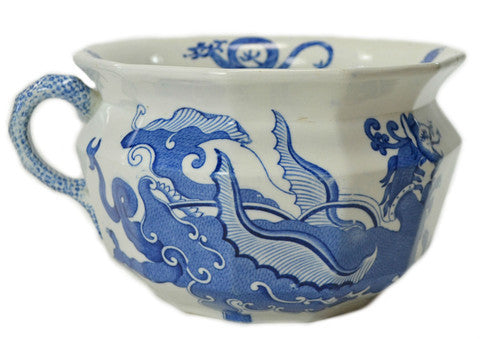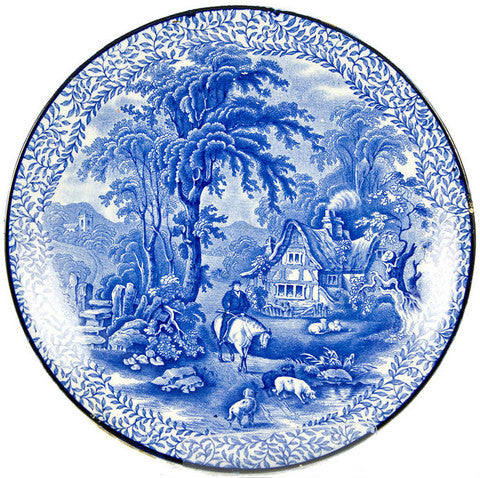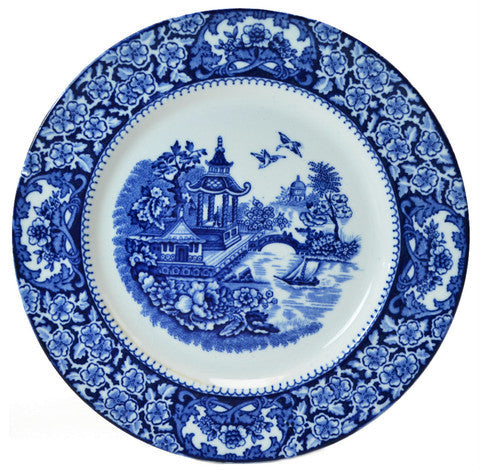Blue & White Transfer Printed Pottery from Staffordshire, England

In 1780 the first earthenware to be transfer-printed in blue and then glazed were made by Thomas Turner at Caughley in Shropshire. The new style of decoration had a strong and immediate effect on the pottery industry. By the end of the 18th century similar wares were being produced in Staffordshire, Lancashire, Yorkshire and South Wales. The first twenty years were largely experimental and most of the patterns were either copied directly from or based on the imported Chinese porcelain.
Early in the 19th century great advances were made. As a result of the invention of the Fourdrinier paper-making machine a more suitable transfer paper became available which enabled the engravers to do finer work, combining stipple with line engraving. Designs were no longer just Chinese copies but scenes appeared which were based on engravings in books on India and the Ottoman Empire, and so did rural scenes with historic houses, abbeys and castles. Many of the plates and dishes had borders of garden flowers, echoing contemporary designs on fabrics and wallpapers. An export trade in blue-printed wares grew rapidly, especially after the Napoleonic Wars of the early 1800’s. North America was the main market and many potters sent shiploads of their blue printed wares across the Atlantic, many decorated with American scenes. They were distributed through agents or even auctioned on the dockside in such ports as Montreal, Boston, New York, Philadelphia and New Orleans. The trade flourished for about fifteen years but declined in the 1830’s with the production of new types of earthenware and the expansion of American potteries. The blue-printed wares produced between about 1805 and 1825 are often of superb quality, fine products of co-operative craftsmanship and practical skill. They are very much collected both in England and in North America. In order to seriously collect these wares, one must first understand how they were produced.

The first stage in the production of blue printed wares was the engraving of copper plates. Dinner services made up the bulk of the production and this involved a whole series of engravings to produce prints to fit plates, dishes, tureens, sauce boats, jugs and strainers, ladles and bowls. Some firms employed their own engravers but there were also a number of outside engravers who sold copper plates to any potter who required them. The plates were engraved more deeply than for book illustrations, particularly in the early days when paper was rather coarse. The porous biscuit absorbed more of the ink. Cobalt blue was used for the printing because it was the only colour at that time which could withstand the heat of the kiln without blurring. The cobalt blue was mainly imported from Germany. The ore of cobalt when roasted produced zaffre, which, when fused with sand and potassium carbonate gave a blue glassy smalt containing a dark-blue crystalline cobalt compound. Supplies of cobalt were interrupted during the Napoleonic wars and the necessary materials were obtained from Cornwall. The cobalt compound was mixed with powdered flint and oil into a viscous ink for printing. The copper plates were first warmed on a palette knife and worked into the details of the engraving. The surface was then scraped and was made wet with soap and water and laid on the copper plate. Pressure was applied and the plate was again warmed on the stove so that the paper could pattern. The transfer of the pattern to the earthenware biscuit was a job for women, a girl cutter trimmed away unwanted paper and a transferrer then placed the paper, ink-side downwards, on the item, rubbing it gently with a roll of flannel. The border was applied separately, usually in two or more pieces, and the joins are often visible. By washing in cold water immediately afterwards, the paper floated off leaving the inked pattern on the ware. This print was then fixed by heating the item in a muffle oven.

The final stage involved covering the pattern with a protective stage involved covering the pattern with a protective glaze. A dipper carefully immersed each piece in the liquid glaze, so that little surplus remained to drain off. This was fixed by heating in a glost oven. Early glazes show a rippled surface and are blue in colour. This colour can be seen very clearly if a plate or dish had a foot rim. By about 1830, however most glazes were smooth and colourless.

Main and Important Pottery Manufacturers of the Blue and White Transfer Wares, and the Dates of their Operation
Thomas Turner
Joshua Heath: 1770-1800
William Adams: 1769-1800
Samuel Alcock: 1794-1836
Thomas & John Carey: 1818-1842
James & Ralph Clewes: 1817-1834
Coalport Porcelain Works, Shropshire (John Rose): 1796-1815
Cornfoot, Colville & Co: 1829-1834
Cornfoot: 1834-1850
John Davenport: 1795-1887
Don Pottery: 1790-1893
The Foley Pottery, Fenton: 1822-1830
Thomas Fell of Newcastle: 1817-1830
Thomas & Benjamin Godwin: 1809-1834
Ralph Hall of Tunstall: 1822-1836
Robert Hamilton of Stoke: 1800-1811
Charles Heathcote & Co of Lane End: 1818-1824
Hicks, Meigh & Johnson of Shellton: 1806-1822
Jones & Son of Hanley: 1826-1828
Leeds Pottery
The Mason Family: 1800-1813
Job Meigh of Hanley: 1805-1812
Job Meigh & Son: 1812-1835
John Meir of Tunstall: 1812-1897
Maddock & Seddon of Burslem: 1820-1840
Minton of Stoke: 1796
The Bristol Pottery: 1816-1830
John & Richard Riley: 1814-1828
Rockingham Works, near Swinton: 1826-1842
The Rogers Family: 1810-1836
Shorthose & Co of Shelton: 1795-1822
The Spode Works at Stoke-on-Trent
Andrew Stevenson of Cobridge
Joseph Stubbs of Longport: 1822-35
The Swansea Potteries
The Cambrian Pottery: 1783-1870
Glamorgan Pottery: 1813-1838
John Turner of Lane End
Wedgwood Blue-Printed Wares: 1806
Wood & Challinor of Tunstall: 1828-1843
Enoch Wood & Sons of Burslem: 1825

View Our Blue & White Collection



